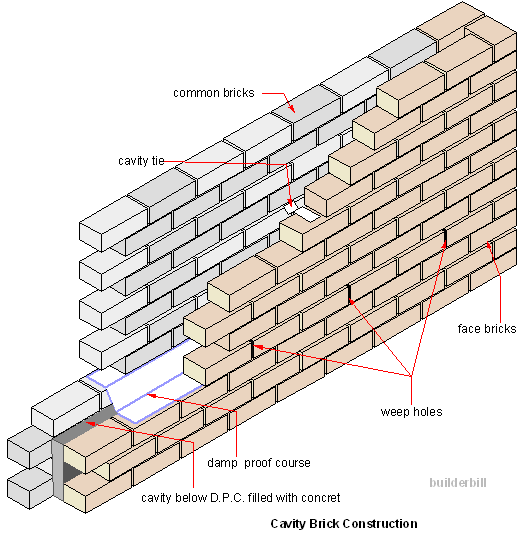 |
||||
Graphical Construction Glossary >> masonry. >> brickwork >> Cavity Wall
These walls because of the cavity are always built in stretcher bond. The architect or designer will usually specify the number and placing of the cavity ties which are essential if the wall has to have any strength at all. The ties come in a variety of patterns and materials. The pressed metal and wire types always have a kink in them at the middle which must always point down to allow any moisture to drip off. The bricklayer lays the ties in the first skin built as the work proceeds and then the second wall when it is being built gets the ties bedded in also. The ties are fixed in a staggered pattern. The DPC can also be a variety of materials. It is usually placed a couple of courses higher than outside ground level. The inside part of the DPC sits one course higher than the outside to allow any accumulated moisture to escape through the weep holes. The weep holes are simple end joints every third brick or so that have no mortar in them. The cavity is normally 50mm or 2" wide. It must be kept clean and no mortar dags should be allowed to bridge the gap between the brick skins. The normal sequence is for the brickies to get all the walls up to DPC height and the the cavities up to that level are filled with concrete. If you didn't find exactly what you are looking for try this
search tool that will search the site and the web. "What can be added to the happiness of a man who is in health, out of debt, and has a clear conscience? "When we build, let us think that we build for ever."John Ruskin 1819-1900 |
Hire Equipment  Furniture Fittings - Architectural Hardware - Electronic Locking Systems - Technical Hardware BuilderBill sponsorship Glossary Pages.Roof Glossary and Roofing Formwork Glossary and other tempory work. Hand Tools Glossary Power Tools Glossary Asbestos Glossary Woodwork Glossary Stair Glossary Concrete Glossary Masonry Glossary doors Glossary BuilderBill Books Building Maths  Stair Design  Asbestos Book |
|||
|
|
||||
|
Please Note! The information on this site is offered as a guide only! When we are talking about areas where building regulations or safety regulations could exist,the information here could be wrong for your area. It could be out of date! Regulations breed faster than rabbits! You must check your own local conditions. Copyright © Bill Bradley 2007-2012. All rights reserved. |
||||
